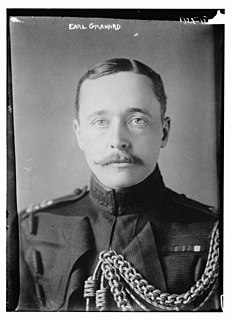Related Research Articles

Earl of Longford is a title that has been created twice in the Peerage of Ireland.

Earl of Granard is a title in the Peerage of Ireland. It was created in 1684 for Arthur Forbes, 1st Viscount Granard. He was a lieutenant-general in the army and served as Marshal of the Army in Ireland after the Restoration and was later Lord Justice of Ireland. He had already succeeded his father as second Baronet of Castle Forbes and been created Baron Clanehugh and Viscount Granard in 1675, also in the Peerage of Ireland. The Baronetcy, of Castle Forbes in county Longford, was created in the Baronetage of Nova Scotia on 29 September 1628 for his father, Arthur Forbes.

Baron Annaly is a title that has been created three times, twice in the Peerage of Ireland and once in the Peerage of the United Kingdom. Annaly is named after the ancient term for the general locale, which in turn was named after the original ancient king. The third creation is currently extant.
This is a list of people who have served as Lord Lieutenant of County Tipperary between 1831 and 1922.

Bernard Arthur William Patrick Hastings Forbes, 8th Earl of Granard,, styled Viscount Forbes from 1874 to 1889, was an Anglo-Irish soldier and Liberal politician.
This is a list of people who have served as Lord-Lieutenant of County Cork.
This is a list of people who have served as Lord Lieutenant of Westmeath.
The following is a list of those who have been Lord Lieutenant of Leitrim.
General William Lygon Pakenham, 4th Earl of Longford, styled The Honourable William Pakenham before 1860, was an Anglo-Irish soldier and Conservative politician.
Viscount Newcomen, of Mosstown in the County of Longford, was a title in the Peerage of Ireland. It was created in 1803 for Charlotte Gleadowe-Newcomen, Baroness Newcomen. She had already been made Baroness Newcomen, of Mosstown in the County of Longford, in 1800, also in the Peerage of Ireland. She was the wife of William Gleadowe-Newcomen, who represented County Longford in both the Irish and British House of Commons. In 1781 he was created a Baronet, of Carrickglass in the County of Longford, in the Baronetage of Ireland. Lady Newcomen was the only child and heiress of Edward Newcomen, of Carrickglass, County Longford, grandson of Sir Robert Newcomen, 6th Baronet, of Kenagh. At the extinction of the Newcomen baronetcy in 1789, the substantial family estates devolved on the future Lady Newcomen. Her husband was born William Gleadowe, but assumed at the time of their marriage the additional surname of Newcomen. Sir William and Lady Newcomen were both succeeded by their son, the second Baronet and second Viscount. He sat as Member of Parliament for County Longford in the British House of Commons. The titles became extinct on his death in 1825.
Henry White, 1st Baron Annaly was an Irish British Army soldier and politician.
George Arthur Hastings Forbes, 7th Earl of Granard KP, styled Viscount Forbes from 1836 to 1837, was an Irish peer and soldier.
Thomas Pakenham, 1st Baron Longford was an Irish peer and politician.
Thomas Gleadowe-Newcomen, 2nd Viscount Newcomen, known as The Honourable Sir Thomas Gleadowe-Newcomen, Bt, between 1807 and 1817, was an Irish politician.
The High Sheriff of Longford was the British Crown's judicial representative in County Longford, Ireland from the 16th century until 1922, when the office was abolished in the new Free State and replaced by the office of Longford County Sheriff. The sheriff had judicial, electoral, ceremonial and administrative functions and executed High Court Writs. In 1908, an Order in Council made the Lord-Lieutenant the Sovereign's prime representative in a county and reduced the High Sheriff's precedence. However the sheriff retained his responsibilities for the preservation of law and order in the county. The usual procedure for appointing the sheriff from 1660 onwards was that three persons were nominated at the beginning of each year from the county and the Lord Lieutenant then appointed his choice as High Sheriff for the remainder of the year. Often the other nominees were appointed as under-sheriffs. Sometimes a sheriff did not fulfil his entire term through death or other event and another sheriff was then appointed for the remainder of the year. The dates given hereunder are the dates of appointment. All addresses are in County Longford unless stated otherwise.
George Forbes, 4th Earl of Granard was an Irish soldier and politician.
The Custos Rotulorum of Longford was the highest civil officer in County Longford.
The Custos Rotulorum of Westmeath was the highest civil officer in County Westmeath. The position was later combined with that of Lord Lieutenant of Westmeath.
References
- Sainty, J. C. "Lieutenants and Lords-Lieutenants (Ireland) 1831-2005". Archived from the original on 2012-08-04. Retrieved 2008-06-07.
- ↑ G. E. C., ed. Vicary Gibbs, The Complete Peerage , vol. I (1910) p. 174, n. (b).
- 1 2 Lodge, John. The Peerage Of Ireland: Or,A Genealogical History Of The Present ..., Volume 2. p. 149.
- ↑ Arthur Aspinall, GLEADOWE NEWCOMEN, Hon. Thomas (1776-1825), of Carrickglass, co. Longford and Killester, co. Dublin. in The History of Parliament: the House of Commons 1790-1820 (1986).
- ↑ The Royal Kalendar for 1825, p. 386.
- ↑ The Royal Kalendar for 1831, p. 389.
| | This Irish biographical article is a stub. You can help Wikipedia by expanding it. |